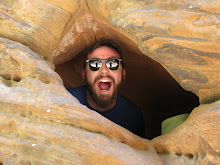


Wildfires, though a natural part of the ecosystem, can cause a variety of problems in graded urban areas. Landslides, debris flow, and flooding are just a few negative events that can result from wildfires that have burned over sloping terrain. Land, mud, or debris flow have a higher potential depending on the gradient of the slope, make-up of the soil, and water saturation. With increased slope gradient and water saturation, soil make-up is less of a factor in slides due to the overwhelming gravitational forces. Though these factors are commonly understood, wildfires effects on slides can be counter intuitive.
The problem with wildfires is when ,as mentioned by US Forest Service, the "intense heat... can cause the soil to 'seal' itself and water will not easily penetrate it." This act of sealing the soil causes the rain runoff to flow directly into creeks and watersheds without the normal absorption from soil and plant life. This additional water acts as a massive storm for the soil and plant life below the burn zones. This additional water can over saturate the soil below and cause land, mud, or debris flows.

This diagram from the Council of Geoscience shows some of the contrast between soil types, saturation levels, and speed of soil movement. The added water flow from the lack of absorption within burn areas can cause the levels of saturation to quickly increase for soils below the burn zones, regardless of the strength of the storm. Though according to the USGS's report on Post-Fire Debris Flow Hazards, the stronger and shorter duration storms have the potential to do the most harm. In order to better monitor the saturation levels in the soil along these target locations of the Angeles National Forest, the USGS has embedded water saturation sensors in the soil. These sensors upload information about the change in saturation in order to be aware of rapidly changing situations.
I have attempted to address these target locations with my GIS maps. The first map indicates the complete burn area of the Station Fire as of September 2nd, 2009. I have complimented this data with a DEM, Digital Elevation Model, of the area as well as county names and boundaries to better orient the data. The second map illustrates the significant relationship between rainfall intensity and elevation. As stated, the importance between these two factors is clear and the overlay analysis can emphasize the target areas. The rainfall data is a compilation of 24 hour periods over a series of 50 yrs. This information becomes an averaged value of rainfall over the 50 year period, indicating a trend of heavier rainfall intensity at higher altitude. This trend is evidence for orographic lifting caused by the increase of moist air in reference to the mountains increase in altitude. An indicator on the map of this trend would be the areas of higher elevation receiving the highest rainfall intensity.
My third map, Slope Map, stands to serve as an indicator of extreme slope that could result in added gravitation force on the saturated soil. As mentioned, the gravitational forces caused by steep slopes can also contribute greatly to slides. In conjunction, these two maps can offer a very insightful view into potential land, mud, or debris flow locations.
Los Angeles County. "GIS Data." Los Angeles County Enterprise GIS. WordPress. 22 November 2009. <http://gis.lacounty.gov/eGIS/?page_id=117>.
U.S. Forest Service. "Post Fire Watershed Rehabilitation Activities." Inci Web - Incident Information System. 26 September 2009. U.S. Forest Service. 22 November 2009. < http://www.inciweb.org/incident/article/9512/ >.
Council for Geoscience. "Landslides and Slope Instability." Council for Geoscience. 14 March 2009. The Collective Advisory (TCA). 22 November 2009. <http://www.geoscience.org.za/index.php?option=com_content&task=view&id=996&Itemid=434&limit=1&limitstart=4>.
USGS. "Emergency Assessment of Postfire Debris-Flow Hazards for the 2009 Station Fire, San Gabriel Mountains, Southern California." 2009. 11 November 2009. <http://www.thecvcouncil.com/sitebuildercontent/sitebuilderfiles/USGS_report.pdf>.
USGS. "2009 Station Fire, Dunsmore Canyon, Glendale California." USGS - Science for changing the world. 13 October 2009. U.S. Department of the Interior. 11 November 2009. <http://landslides.usgs.gov/monitoring/dunsmore/>.








